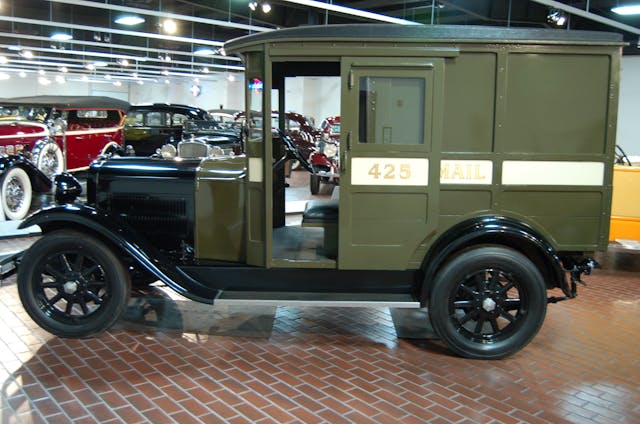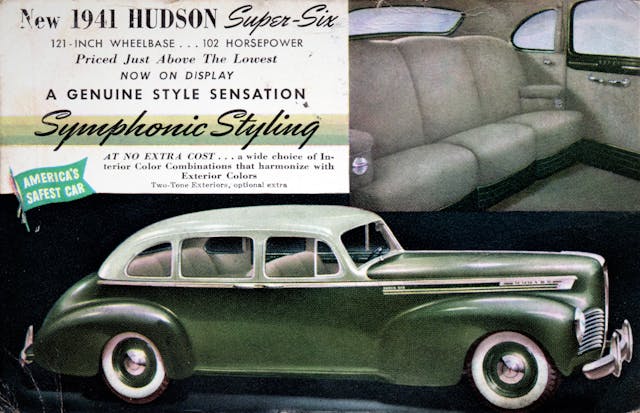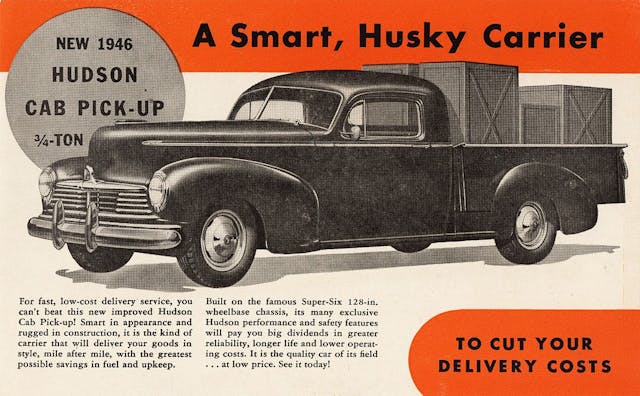Did Ute Know? The first car-based pickup was not a Chevy
For a group that likes to call themselves car people, automotive enthusiasts have an odd affection for cars that look like trucks: The Chevrolet El Camino, the Ford Ranchero, and the Subaru Brat.
Whatever you call these oddities—car-truck, truck-car, cowboy Cadillac, ute—it’s tempting to say that they trace their lineage back to Henry Ford and the 1917 Model TT truck. Though early Ford cars and trucks are obviously related, the TT was a purpose-built utility vehicle with a more substantial frame and drivetrain. Typically, car-based trucks have gone in the other direction, borrowing their mechanicals from automobiles, not trucks, and tilting the utility/luxury balance more towards the latter.
So, if not the Model TT, which vehicle is the true founder of the car-truck line?

Since I haven’t done a Marianas Trench–level dive into the subject, I can’t say with 100 percent certainty that it was independent automakers Studebaker and Hudson that first introduced actual car-based pickup trucks to the American market. However, I believe that the 1937–39 Studebaker Coupe Express and the 1941–47 Hudson Cab Pick-up (including the 3/4 ton “Big Boy” models) are among the very first American vehicles that combined pickups’ cargo beds with the styling, sheetmetal, and mechanical componentry of those brands’ passenger cars.
Introduced for the 1937 model year, the Coupe Express was based on the Studebaker Dictator. In case you’re wondering why Studebaker would choose a model name associated with despots, the Dictator nameplate was introduced in 1927, before Hitler, Mussolini, Franco, and Stalin had solidified the word’s modern connotations. If the branding scheme is now awkward, it was at least coherent: Dictator was the entry-level Studebaker, below the midrange Commander and flagship President.


Power was supplied by Studebaker’s larger, 218-cubic-inch (3.6 liter) L-head inline six-cylinder producing 86 horsepower, driving through a three-speed manual transmission, with an optional Borg-Warner overdrive available. Typical passenger-car options like radios, heaters, and turn signals were available. You could even choose from two different styles of steel wheels. (Yes, young Padawan, things like heaters and turn signals were not always standard equipment, let alone air conditioning. Before the 1976 Honda Accord, cars were very much priced à la carte.) About 3000 units of the introductory Coupe Express were sold. Advertising touted the “passenger-car comfort and style … combined with useful business body types.”
For the 1938 model year, the cab of the Coupe Express was updated to reflect styling changes on the passenger cars. In this case, styling alterations made the vehicle more practical: They allowed for a slightly longer cargo bed, which featured a sharp-looking, backwards-sloped tailgate. Despite the styling changes, sales dropped by almost two-thirds to around 1200 trucks. Again, the 1939 models were restyled to reflect Studebaker’s cars, but sales of the utes dropped even more, to just about 1000 units. The Coupe Express was discontinued to be replaced in 1941 by a 1/2 ton model of Studebaker’s more conventional M-Series pickup in 1941.
Hudson, on the other hand, never developed a dedicated truck line. You could well argue that all of Hudson’s pickup trucks, in fact all of its light commercial vehicles, were car-based. This wasn’t a bad thing, since Hudson’s automobiles were regarded as robustly overbuilt; perhaps they were suited well for the task of being car-truck hybrids.
In 1929 Hudson’s Dover truck brand started selling a line of commercial vehicles based on the parent company’s Essex automobiles, equipped with pickup beds, side-express bodies, or custom bodies made by the Hercules company in Kentucky. The United States Postal Service was a major customer, buying 500 of the car-based trucks, presumably for mail delivery. One of those postal utes, shown below, long resided at the Hostetler Hudson Museum in Shipshewana, Indiana, which closed in 2018.

Hudson also sold those same vehicles under the Essex brand, with slight changes. In 1932, a new line of pickups and sedan deliveries were offered, based on the Terraplane. With the Great Depression going on, sales were modest and peaked at about 8000 units in 1937.

That year, Hudson’s lineup of what it called Commercial Cars was expanded to also include a cab and chassis model, a sedan delivery, a station wagon, plus a “Utility Coupe,” which had a small pickup box that pulled out like a drawer from the trunk, and a “Utility Coach,” a two-door sedan with removable seats and panels to cover the rear quarter windows.
For the 1939 model year, the lineup was expanded yet further, offering three different wheelbases and multiple trim levels, all of them with car styling. That year the heavy-duty 3/4 ton Big Boy trucks were introduced. In 1940, when Hudson cars got new front-end styling and A-arm front suspensions with coil springs, the trucks shared those modern developments.
The Hudson trucks introduced in 1941 were probably the most car-like. Hemmings describes them as “low, long and dripping with chrome,” looking “like something dreamed up by a customizer… rather than the product of a mainstream American automaker.” Contemporary advertising focused on “new beauty and style,” plus “passenger car roominess and comfort.”

The fact that the ’41 Super-Six is considered by Hudson enthusiasts to be one of the marque’s most attractive products didn’t hurt. The half-ton Cab Pickup and the three-quarter-ton Big Boy models were based on 116- and 128-inch wheelbase versions of the Super-Six Commodore. Though those were midrange cars, they had substantial frames with 7 3/8″-inch tall rails and four lateral crossmembers augmented by a stiff X-member. The independent A-arm, coil-sprung front end was billed as “Auto-Poise Front Wheel Control,” the rear end had leaf springs with a track arm, and all four corners were dampened with modern hydraulic tube-type shock absorbers. The trucks did feature stiffer springs than the passenger cars and the Big Boy’s brakes 11-inch drums came from the parts shelf for the Hudson Eight.

The Hudson pickup may have been based on a sedan, but even the shorter-wheelbase model had a full-steel pickup bed measuring more than 48 inches between the inner fender walls and 93 inches front to back: With the tailgate down, you could carry a full sheet of plywood. On the inside, the dashboard offered the sedan’s clock, “Weather-Master” heater, Zenith radio, and deluxe steering wheel with a chrome horn ring as optional features. Super Six mechanicals were included as well, with Hudson’s 212-cubic-inch inline six driving through a column-shifted three-speed transmission that, like the Studebaker’s, was also available with an overdrive.
The war-shortened 1942 model year introduced Super Six sedan features such as slicker, restyled fenders and a flared lower body to hide the running boards. As with most cars in the immediate postwar period, the 1946 models were much like the prewar cars except for a new grille. The pickups, although they were some of the first postwar vehicles that Hudson made, still retained the earlier body style with exposed running boards—possibly due to their lower volume compared to the cars.

When Hudson introduced its innovative “Step-down” 1948 models, the firm stopped making pickup trucks as they were not compatible with the new model’s semi-unibody construction. While one prototype was reportedly developed, Hudson would never make another production pickup truck, car-based or otherwise, again. The company would merge with Nash to form American Motors in 1954.
Can we say with absolute certainty that Studebaker and Hudson made America’s first car-based pickups? No, but one thing’s for sure: Chevrolet and Ford were fashionably late to the party.
***
Check out the Hagerty Media homepage so you don’t miss a single story, or better yet, bookmark it. To get our best stories delivered right to your inbox, subscribe to our newsletters.



Every time I see one of those ’30s-’40s Hudson pick-ups, I marvel at how beautiful it is. Since they were “overbuilt” even as cars, my assumption is that they were also rugged performers in the work arena. But to me, they are just darned good-looking vehicles!
Want to get technical you can go back to the original International Harvesters. There were no trucks and they built a wagon that was both car and bed. It was the first car my great uncle ever saw as a kid in Millersburg Ohio over 100 years ago.
True, and in 1907.
Ford beat them both again. Not with the TT but with the Model T pickup. It was first produced by the factory in 1925. It had the pickup bed on a runabout chassis.
I agree, the Model T (not the heavier TT) was available with a pickup bed, so I also believe it was first.
You are quite right; as the Ford Model T “Roadster Pick-up” was way ahead of the others. Starting at least as far back as 1921, the model T had a removable “Turtle Deck” or “Turtle Back” that was bolted to the back of the roadster body, containing a “trunk” for securely stowing things. By removing a few bolts, the turtle deck could be replaced with a Ford-made, pick-up bed, resulting in a Model T Roadster Pick-up. Many years ago, I had a 1926 Model T Roadster Pickup that had a little “sub-frame” behind the roadster body, which supported the pick-up bed. When the pick-up bed was unbolted, the little sub-frame perfectly fit the turtle deck, which was about a foot shorter than the pick-up bed. Therefore, a roadster could be switched to a pick-up or vice-versa. Studebaker and Hudson were simply, Johhny-Come-Latelys!
You need to qualify your statement – Studebaker and Hudson were the first to produce “styled” commercial vehicles based on the passenger car body. Early prewar vehicles (other than the high end likes of Peirce Arrow with their integrated headlights in the fenders) had virtually no “styling” – much-less to differentiate cars from commercial vehicles. You need to limit the discussion to those produced AFTER dedicated light commercial vehicles were produced alongside passenger cars by some of the same companies.
I seem to recall our neighbor on the next farm over from ours had a 37 or 38 Chevy coupe that had an insert in what was the trunk to convert it into a pickup .
I remember seeing a 1941 Hudson pickup as a kid and thinking it was really good looking for a truck. also I remember Plymouth offered a slide in bed for their business coups in the 1930’s.
Yeah, the Ford Model T was obviously earlier, but it was the Model A (not AA) that really defined the car-based pickup. Available in both roadster and closed cab versions, many are still on the road today.
And all this time I thought Hudson offered the first car/pickup.
I think that Chevy coupe was called a
Business Coupe, but I have slept since then.
In Rhodesia and South Africa they were called a Coupe Imperial if memory serves me correctly.
Ford built one of the most beautiful trucks ever (in my view) in 1940 and 1941. I believe Edsel Ford worked with chief designer Bob Gregorie (often against the wishes of Henry) to design some beautiful cars AND trucks. In 1942 war production dictated a different design. Alas, I sold my completely restored 40 Ford pickup a few years ago. Sad but true.
Darrell – Sorry to hear that! It is my favorite of all time.
I agree that ’40/’41 Ford pick-ups are fantastic-looking trucks. I’ve know several people who had them over the years, and I always admired them. I came close to buying one (the cast-off of a friend who was building a much nicer one), but it was a tad bit too much money for me. It sold really quickly, though.
How is that any different from the model T or A or even a later one
The cars and pickups back then shared a lot of parts .
I’m no expert but I’m pretty sure the model A pickup was the same as the car. Just with a bed in the back
Those would have made the ultimate 1950’s shop trucks on the SoCal hot rod scene. Turn Big Daddy Roth or Von Dutch loose and stand back as fine art is created.
I like the slide-out tray option, have never seen that. It looks pretty useful. Tossing common sense aside, my kids would love riding in the tray.
Leave the tray unlocked and it can slide in and out during stops and go’s to give them the extra scare
In the late 1970s I had a maroon 1937 Terraplane 3-window coupe with the Hudson type sliding pickup bed hidden under the trunk lid. After opening the trunk lid and making sure the 2 lid supports were locked in place, to move the bed in and out of it’s location in the trunk area, you turn 2 levers at the end of the box. These levers are spring loaded and on release they would lock it in place in several different lengths. No kiddie ride there!
I took the Terraplane to a few local car shows one summer before selling it. Prior to driving to one meet, I opened up the trunk lid and extended the bed, then filled it with hay bales. I dressed like a farmer from the 1930s [very worn bib overalls, checkered shirt, and straw hat] and entered the coupe in the show, hay bales and all. I kept being asked to pose at the back of the car for photos, which I gladly did.
In 2012 I was attending the Hudson-Essex-Terraplane club’s national meet in Gettysburg, PA, and I spotted a 1937 Terraplane coupe pickup in the same color maroon. Looking it over carefully, I noted a couple of non-original items on the vehicle that matched my car years ago. Yep, it was most certainly my car, 35 years later.
They look like a trucj to me. They look great regardless of truck or car based truck.
Wrong – the Ford Model A, 32, 33/34 all had roadster pickups using the passenger car cowl forward sheet metal and frames. You didn’t even go snorkeling for your info!
1907 was the first International Harvester wagon/truck. Ford was much later.
I was thinking the International was the first one as well.
But I believe Sears made several similar ones that were in the 1910 range and before as well along with the Dodge Brothers 20’s something screen sides , like the one my sister has.
I’m sure there are others that I’m not aware of but those are just a couple that come to mind for me.
ranchero came before el camino
ford before chevy
but chevy lasted longer